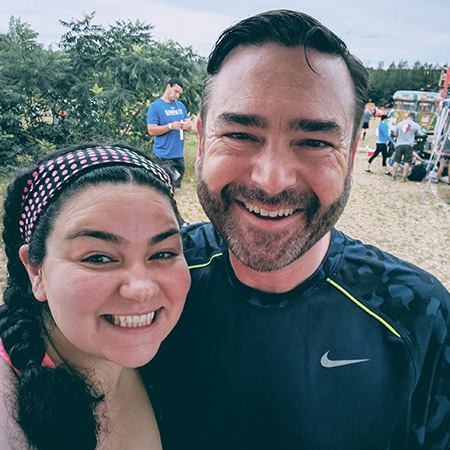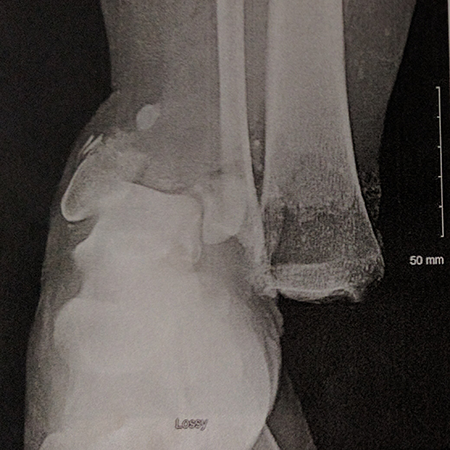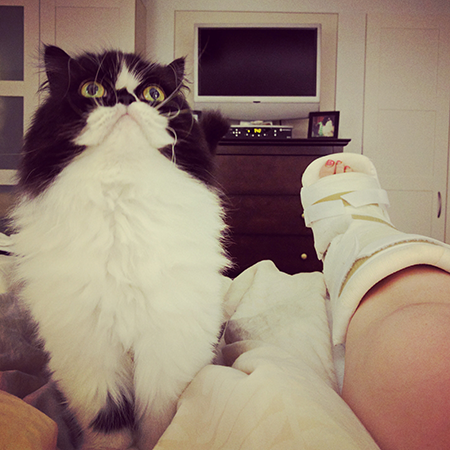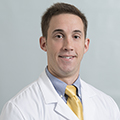Patient StoryJan | 31 | 2023
Miriam’s Story: A Traumatic Fall on an Extreme Obstacle Course Leads to a Near-Amputation and a Renewed Appreciation for Mobility

When Miriam Talamini agreed to sign up for an obstacle course mud run with her boyfriend, an EMT in Boston who had already run two such races, she had no idea that the event would put his emergency medical training to the test and lead to her undergoing 15 corrective surgeries. She trained for weeks prior to the August 2016 event, held in southern New Hampshire, and showed up on race day pumped for a day of fun challenges.
The first obstacle Miriam came across was a climb over hay bales and under barbed wire, and despite getting covered in mud, she made it through relatively unscathed. The next obstacle was a vertical wall she would need her boyfriend and a fellow competitor to hoist her over. Because Miriam was not an experienced obstacle course athlete, she and her boyfriend agreed that if any of the day’s challenges were too tough, they would simply walk around them and continue the course; their goal was just to cross the finish line.

As she was being hoisted up and over the wall, Miriam suddenly felt like this particular challenge was not something her body was meant to do, so she announced she would jump down and walk around the wall. Unfortunately, the long drop back onto the soft, muddy ground put all of her body weight onto her leg and ankle at an odd angle, causing her joint to dislocate and several bones in her ankle to break quite severely. The injury was made even worse by significant surrounding tissue wounds and open contamination from the mud. With the help of event organizers, Miriam was transported to a local hospital, where the doctor attempted to stop the bleeding and closed her wound to prepare her for transfer to Massachusetts General Hospital three days later.
A Family History of Mass General Care
Miriam's grandparents settled in Boston’s North End neighborhood, and, growing up, her family all saw the same doctor at Mass General, who they came to know and trust. Even though that family doctor eventually passed away, Miriam and her family still consider Mass General "their" hospital, so, when she suffered this traumatic leg injury, Miriam made it clear she wanted to go to Mass General for care as soon as that was possible.
At Mass General, Miriam received care from a team comprised of an orthopedic trauma surgeon, plastic surgeon Kyle Eberlin, MD, and countless nurses, physician assistants and physical therapists. Her team cleaned out her wound further, placed a metal implant designed to aid healing and support bone growth, and constructed a flap meant to cover the wound area. Following her surgeries at Mass General, Miriam was transferred to the Spaulding Rehabilitation Network and then cleared for release six weeks after the injury.
A Long Road to Recovery
In the year following her accident, Miriam experienced several complications. A week after being released from the Spaulding, an infection set in, so she enlisted the help of Michael Aronoff, MD from Mass General’s Infectious Disease team. She also underwent multiple revision surgeries to maintain/reset the implant, along with plastic surgeries aimed at improving the appearance of her leg. Miriam was learning that, with severe trauma like she had experienced, the road to recovery can be a long and difficult one, laden with unforeseen developments and setbacks.

After nine surgeries, Miriam began to grow despondent; the bone and tissue in the area of her injury were dying, and her leg was not healing well. Miriam decided to research alternative treatments and approaches, and sought a second opinion on her surgical plan from the Chief Emeritus of Mass General's Foot & Ankle Service, Christopher DiGiovanni, MD.
Miriam met with Dr. DiGiovanni and was encouraged by his confident, optimistic approach and expertise. She says that he listened to her concerns, expressed a willingness to take her treatment in a new direction, and collaborated with her on the care plan. For her next orthopedic surgery, Miriam’s metal implant was removed by Dr. DiGiovanni, and a three-dimensional external fixation device was attached to her leg. External fixation protects and stabilizes the affected bones and encourages fusion and growth, but can be less prone to infection, since it is largely outside the body. Miriam thought of the fixator as an extreme form of body jewelry, and so she asked Dr. DiGiovanni if she could add some “bling.” His team obliged by including a shiny gold-colored ring in the middle of the device.
"Almost immediately, Dr. DiGiovanni became more than my surgeon: he was a friend," Miriam says. "I remember, at a time when I was particularly discouraged and exhausted by the ups and downs of the recovery process, I asked if he would just amputate my leg. He looked at me and said, 'We're not there yet. I am not giving up on you or this leg.’ I knew that we were truly on this journey together."
Trying a New and Different Approach
Next, Miriam underwent a bone transplant with Dr. DiGiovanni, and was fitted with a special, three-dimensional Taylor spatial frame device on her lower leg. With a few alignment adjustments and the gradual removal of hardware, the bones moved into their proper positions and Miriam was on the road to recovery. She fused what was left of the bones in her ankle and lower leg, allowing her to keep her foot and have some function and stability, but there was only 60-65% of her native bone left in the area to do the support work required to stand and walk safely and steadily. With Dr. DiGiovanni's guidance, she soon discovered a new type of prosthetic device being developed across the country that would allow her to help load the injured ankle without compromising fixation or progressive mobilization. At that time, Dr. DiGiovanni had had two other patients with similarly complex foot problems who had tried the brace, and it seemed to help their healing process.
Miriam's friends banded together to crowdfund the $13,000 she would need to travel and purchase the experimental device. During her trip, Miriam was fitted with the prototype and went on a hike in the forest, free from pain. It had been 26 months since she had been able to walk independently, without crutches, and so those first steps felt to Miriam like she was flying. By June of 2018, Miriam reached 100% fusion of her ankle, complete eradication of her infection and, with the help of plastic surgeon Kyle Eberlin, MD, fully healed surrounding soft tissues.
Back on Her Feet and Moving Forward
Despite all her training and preparation, Miriam never crossed the finish line on the day of her injury, and she wanted some sort of closure for the goal she had set for herself. In July 2018, she completed the Run to Home Base 5k at Fenway Park, running with a team of friends, nurses, EMTs and others who had supported her on her path to recovery, all wearing t-shirts she had made that acknowledged her entire support team.

Miriam had an epiphany during her recovery; she realized that, consciously or subconsciously, her world had become very small; home was the safest and most familiar environment, and she had begun limiting herself and her mobility even beyond the constraints of her injury. With leg injuries, patients often feel a temptation to stay home and immobile while recovering. Miriam had to make a safe but deliberate plan to get out more, to walk around and see the world in ways she never did before her injury. She has a newfound appreciation for her mobility and is forever grateful to her supporters, especially her medical care team, for helping her along her journey.
Today, Miriam continues to see Dr. DiGiovanni, his PA Brian Abbott and Dr. Eberlin, and the rest of her Mass General care team at regular intervals for follow-up appointments, but she feels completely recovered and more active than ever. She walks vigorously in regular footwear, without brace support of any kind, and the memory of her injury is receding into her past as she moves on with her life. Miriam is so pleased with Dr. DiGiovanni’s care that she has scheduled an unrelated procedure with him for her uninjured foot next month at Mass General.
Miriam TalaminiAlmost immediately, Dr. DiGiovanni became more than my surgeon: he was a friend … I knew that we were truly on this journey together.
Mass General trauma patient
Miriam's Team
-
![]()
- Physician Assistant with Dr. Christopher DiGiovanni
-
![]()
- Professor of Orthopaedic Surgery, Harvard Medical School
- Chief Emeritus, Foot & Ankle Service; Past President, American Orthopaedic Foot and Ankle Society
- Foot & Ankle Consultant for Athletes from US National, Professional and Collegiate Programs
-
![]()
- Associate Professor of Surgery
- Program Director, Harvard Plastic Surgery Residency Program
- Associate Program Director, MGH Hand Surgery Fellowship



